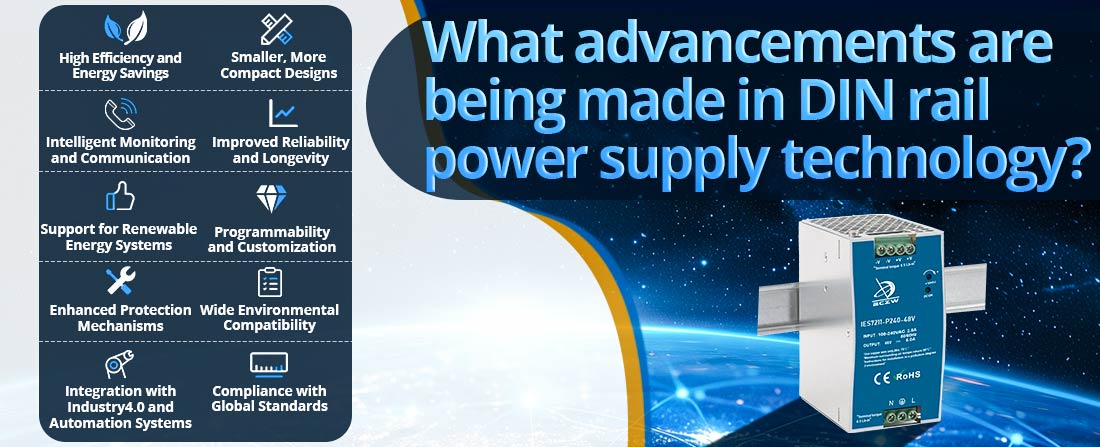
Los avances en la tecnología de suministro de energía en riel DIN están siendo impulsados por la creciente demanda de eficiencia, confiabilidad y operación inteligente en aplicaciones industriales y comerciales modernas. Estos desarrollos se centran en mejorar el rendimiento, la gestión de la energía y la integración con los ecosistemas de Industria 4.0 e IoT.
Avances clave en la tecnología de suministro de energía en carril DIN
1. Alta Eficiencia y Ahorro Energético
--- Eficiencia de conversión mejorada: las fuentes de alimentación modernas logran eficiencias superiores al 95 %, lo que reduce la pérdida de energía durante la conversión de energía.
--- Operación en modo ecológico: los modos inteligentes de ahorro de energía reducen el consumo de energía durante condiciones de baja carga.
--- Amplios rangos de voltaje de entrada: admite aplicaciones globales y diversas fuentes de energía, incluidos sistemas de energía renovable.
2. Diseños más pequeños y compactos
--- Mayor densidad de potencia: Los mecanismos de enfriamiento avanzados y los componentes de alta eficiencia permiten a los fabricantes diseñar unidades más pequeñas sin sacrificar la potencia de salida.
--- Factores de forma que ahorran espacio: el tamaño reducido ayuda a optimizar los diseños del panel de control en industrias donde el espacio es limitado.
3. Monitoreo y comunicación inteligentes
--- Integración de IoT: las fuentes de alimentación ahora cuentan con interfaces de comunicación como Modbus, Ethernet/IP, CAN bus y PROFINET para monitoreo en tiempo real y control remoto.
--- Conectividad en la nube: la integración con plataformas en la nube permite a los usuarios monitorear el rendimiento, predecir fallas y optimizar el uso de energía de forma remota.
--- Diagnóstico integrado: las funciones avanzadas de autodiagnóstico brindan alertas para problemas como sobrecarga, sobrecalentamiento y componentes degradados.
4. Mayor confiabilidad y longevidad
--- Funciones de mantenimiento predictivo: Los sensores monitorean los componentes internos (por ejemplo, capacitores) para predecir el final de su vida útil, lo que permite un mantenimiento proactivo.
--- Diseños robustos: la protección mejorada contra factores ambientales como el polvo, la humedad y las temperaturas extremas garantiza una vida operativa más larga.
--- Módulos de redundancia: Los sistemas de redundancia avanzados permiten un suministro de energía ininterrumpido en aplicaciones críticas.
5. Apoyo a los sistemas de energía renovable
--- Amplios rangos de entrada: Diseñado para funcionar sin problemas con fuentes de energía fluctuantes, como paneles solares o turbinas eólicas.
--- Conversión DC-DC: Permite la compatibilidad con sistemas de almacenamiento de energía e infraestructura de energía renovable.
--- Seguimiento del punto de máxima potencia (MPPT): integrado en algunos modelos para optimizar la recolección de energía de los paneles solares.
6. Programabilidad y personalización
--- Salidas ajustables: Los modelos avanzados ofrecen salidas de voltaje y corriente configurables para adaptarse a requisitos de carga específicos.
--- Funciones programables: Incluye tiempos de retardo ajustables, configuraciones de falla y modos de operación para aplicaciones personalizadas.
7. Mecanismos de protección mejorados
--- Corrección activa del factor de potencia (PFC): Minimiza la distorsión armónica, mejorando la eficiencia y el cumplimiento de los estándares globales.
--- Protección contra sobretensiones mejorada: Protege los equipos conectados de picos de voltaje causados por rayos o transitorios de conmutación.
--- Gestión avanzada de sobrecarga: las funciones inteligentes de limitación de corriente evitan daños durante condiciones de sobrecarga.
8. Amplia compatibilidad medioambiental
--- Funcionamiento a temperaturas extremas: Los nuevos diseños pueden funcionar en una amplia gama de temperaturas, desde -40 °C hasta 70 °C.
--- Recubrimientos conformales: Protege los componentes internos de la corrosión en ambientes hostiles.
--- Resistencia a vibraciones y golpes: Garantiza durabilidad en aplicaciones como transporte o maquinaria pesada.
9. Integración con Industria 4.0 y Sistemas de Automatización
--- Gestión de energía en tiempo real: proporciona información sobre el consumo de energía para la optimización energética en fábricas inteligentes.
--- Compatibilidad de automatización: se integra perfectamente en controladores lógicos programables (PLC) y sistemas de control distribuido (DCS).
10. Cumplimiento de los estándares globales
--- Regulaciones de diseño ecológico: Cumple con estrictos estándares ambientales y de eficiencia energética, como la Directiva ErP y RoHS.
--- Certificaciones de seguridad: Cumple con los requisitos para ubicaciones peligrosas (por ejemplo, ATEX, IECEx) e industrias como la atención médica o la automoción.
Tecnologías emergentes en desarrollo
1. Control de energía digital:
--- Reemplazo de componentes analógicos con sistemas de control digital para una regulación precisa de voltaje y corriente.
2. Componentes de carburo de silicio (SiC) y nitruro de galio (GaN):
--- Ofreciendo mayor eficiencia, velocidades de conmutación más rápidas y factores de forma más pequeños.
3. Fuentes de alimentación inalámbricas:
--- Exploración de la transmisión de energía inalámbrica para reducir la complejidad del cableado en entornos industriales.
Industrias que se benefician de estos avances
--- Fabricación y automatización: respaldando el cambio hacia la Industria 4.0 con sistemas inteligentes e interconectados.
--- Energía renovable: mejora de la eficiencia y confiabilidad de las instalaciones de energía solar y eólica.
--- Atención médica: suministro de energía limpia y estable para equipos médicos sensibles.
--- Transporte: Garantizar durabilidad y confiabilidad en ambientes hostiles.
Conclusión
Fuentes de alimentación en carril DIN están evolucionando para satisfacer las demandas de las industrias modernas incorporando mayor eficiencia, inteligencia y flexibilidad. Estos avances los hacen indispensables en la automatización, los sistemas de energía renovable y otras aplicaciones críticas, lo que garantiza un suministro de energía confiable al tiempo que reduce los costos operativos y permite una gestión energética más inteligente.